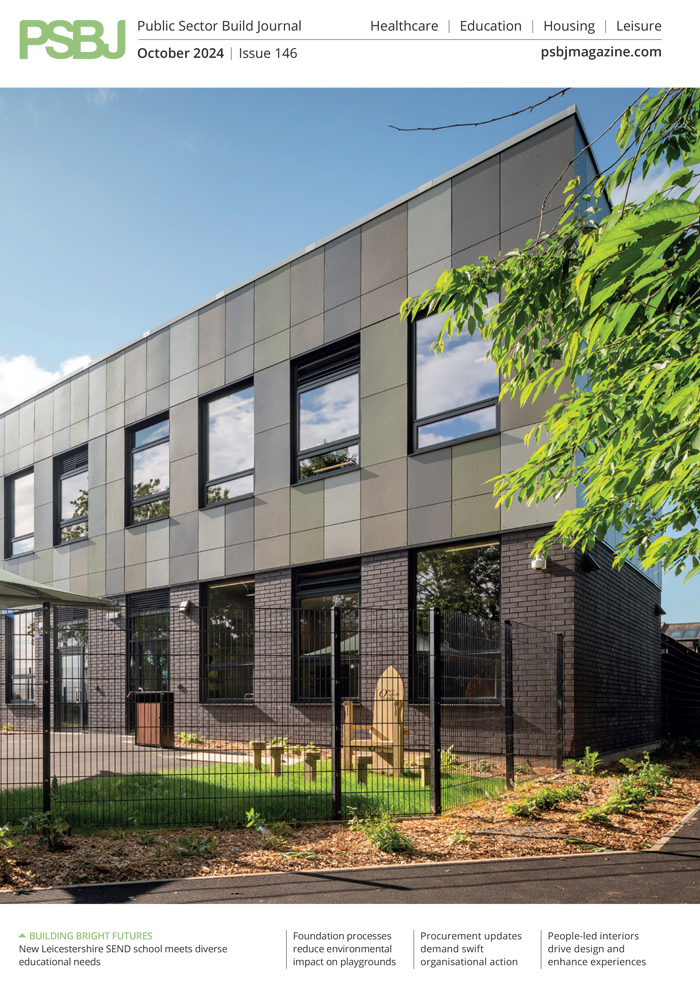Phil Griffiths from Soprema UK explains how excellent classroom acoustics can enhance teaching and learning, and addresses the importance of building the right acoustic performance to maximise occupant comfort and adhere to Building Regulations.
Soprema
Studies have found good acoustic performance benefits both staff and students by enhancing teaching and learning, improving student behaviour and reducing the risk of vocal strain for teachers.
Traditionally, schools were never built with high-quality classroom acoustics in mind, and so architects and specifiers should be aware of the importance of correct material specification during new-build or refurbishment works within educational settings.
Noise source
Poor acoustic design can lead to excessive noise levels, which can cause distractions and make it difficult for students to hear and understand their teachers.
One of the main sources of noise in schools is the sound of its occupants talking and moving around the building. This can be exacerbated by hard surfaces, such as concrete floors and walls, which can reflect sound and make it travel further.
Another important aspect of acoustic performance in schools is the design of classrooms. Learning environments that are planned with acoustics in mind can help to reduce background noise and improve speech intelligibility; making it easier for students to hear and understand their teachers. This can be achieved by using materials and design elements that absorb sound and by positioning desks and other furniture in a way that minimises sound reflections.
In addition to improving the learning environment for students, good acoustic performance in schools can also benefit teachers. Excessive noise levels can cause fatigue and stress, which can negatively impact a teacher’s ability to effectively do their job. By providing a quiet and comfortable learning environment, teachers can work more effectively and provide a better educational experience for students.
Reference to the UK Department for Education’s (DfE) Acoustic Design of Schools: Performance Standards Building Bulletin 93 (BB93) should be considered during design stages. This regulatory guidance describes how acoustic considerations play a key part in any school building, and sets out minimum performance standards.
The Building Regulations state that “each room or other space in a school building shall be designed and constructed in such a way that it has the acoustic conditions and the insulation against disturbance by noise appropriate to its intended use”.
Noise transmission
Noise transmission between two enclosed areas in a building can occur through three different routes, starting with direct transmission through surfaces, flanking and direct impact on the structure.
Direct transmission, also known as airborne noise, occurs when incident waves cause a construction element to vibrate, transmitting their deformation to the air in the adjacent area, creating the ‘drum’ or ‘diaphragm’ effect.
Flanking is another form of noise transmission, in which sound pressure causes not only the dividing wall to vibrate but also all adjacent surfaces, leading to noise production in the next door area.
Direct impact on a structure can also lead to noise transmission. Examples include footsteps, vibrations caused by electrical goods or even machinery, and any noise caused by direct impact with a construction element. These noises, known as impact noise, generate a series of vibrations that spread quickly throughout the entire structure, with little energy loss.
Acoustic solutions
Insulation and acoustics should be a priority when it comes to public sector building, especially during school construction. At Soprema UK, we work with specifiers and developers to help improve the quality of life for the occupiers of buildings, through ensuring better acoustic comfort.
Speaking with a trusted insulation manufacturer from the outset, such as Soprema UK – a company that offers a highly-efficient acoustic insulation materials that can soundproof buildings, as well as offering in-house technical support – should be considered particularly for wall and roof design in schools.
Soprema’s Tecsound product, for example, is a polymer-based, bitumen-free, high-density synthetic soundproofing membrane, suitable for public sector specifications. An ideal solution against airborne (traffic) and impact noise (rain, for example); the upper surface is provided with a non-woven polypropylene reinforcement fleece to offer more protection.
For sustainability considerations, Soprema’s Pavatex wood-fibre insulation is made of wood waste, collected from sawmills before being heated and pressurised into boards. It has excellent acoustic and thermal insulation properties. Acoustically, it keeps out loud noises, which may prevent building occupants from focusing, and provides a quiet and peaceful indoor environment.
Another offering from the Pavatex range is Pavatextil P, which is a three-in-one insulation solution to protect from cold, heat and noise. As a cotton-fibre-based thermo-acoustic insulation, Pavatextil P regulates humidity and retains its initial thickness and insulating power whilst offering outstanding sound-insulation properties.
In addition, Soprema’s multi-functional ISOLAIR insulation board is a two-in-one solution that offers excellent acoustic insulation for walls and roofs. This high-mass product greatly contributes to airborne and impact sound resistance.
All Soprema’s insulation solutions have excellent acoustic and thermal insulation properties, meeting the high demands of our built environment, and keeping building occupiers happy, healthy and warm.
Soundproofing for the future
The importance of acoustic performance in school construction cannot be overstated. By designing schools with good acoustics, we can create a more conducive learning environment for students and teachers, and improve the overall quality of education.












